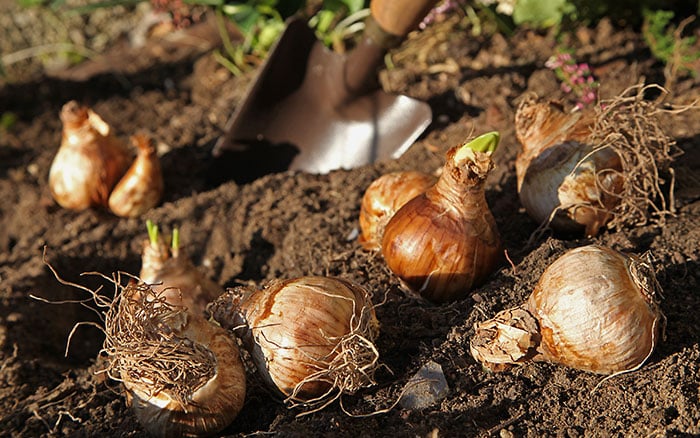Daffodils are a symbol of spring, signifying new life and the growing season ahead. After winter they are a wonderful sight, seeing the yellow flowers bloom is sure to put a smile on your face. So, here’s how to plant daffodil bulbs to have cheery plants in spring.
Planting bulbs
Bulbs are energy powerhouses that bloom year after year. They store their energy over the winter, before bursting to life in spring. You can’t go wrong with bulbs, but there are a few things to bear in mind to help them grow their best.
Between September and November get started by choosing a sunny spot with well-drained soil. They don’t appreciate wet and poorly-drained sites because it causes the bulb to rot. When planting, dig a hole that is two to three times the depth of the bulb itself, then line the bottom of the hole with grit or sand.

Then, the bulbs can be put into place using the lightbulb technique. This involves pushing and twisting the bulb into the soil to ensure there are no gaps for water to collect and result in the bulb rotting.
Remember to plant the bulb the right way, with the point facing upwards.
Naturalising bulbs

Narcissus look great when planted en masse, where they form sheets of yellow flowers that have a vibrant effect. However, they also look fantastic when naturalised in the lawn.
Do this by digging up the turf in autumn, planting the bulbs and laying the grass back down. In spring, they will push through, giving a burst of colour amidst the green grass.
Dividing daffodil bulbs
If an established group of bulbs starts blooming less, it’s probably a sign that the bulbs need dividing. Daffodils are prone to overcrowding, so carefully dig up the bulbs after they have finished flowering.
When they have been dug up look for the small offsets that grow on the side of the large bulbs. These can then be detached from the main bulb. These smaller bulbs can take a couple of years to grow big enough to flower, so the larger the offset, the sooner it will flower.

The new bulbs can be replanted, giving them plenty of space to grow. Alternatively, plant the offsets into containers to give them a head start, ready to plant out once they have grown big enough. At the same time, replant the original bulbs, spreading them out so they have sufficient room to grow too.
Types to try
‘Rapture’
This is a distinctive type of daffodil, with a long trumpet that have petals that have the appearance of being windswept. An interesting addition to the garden, they have the classic bright blooms of a daffodil that look fantastic naturalised in grass.
- Flowers in March and April
- Fully hardy
- Grows up to 30cm tall
- Well-drained soil
- Full sun or partial shade
- Sheltered or exposed

‘Avalanche’
The white petals frame the short yellow cup, giving a charming appearance that’s different to the long-trumpet varieties. A pretty addition to your spring garden, this old-fashioned variety can produce up to 15 flowers per stem.
- Flowers in March and April
- Fully hardy
- Grows up to 40cm tall
- Well-drained soil
- Full sun or partial shade
- Sheltered or exposed

‘Tahiti’
This may not look like the traditional daffodil, but the colouring is sure to add some cheer to your spring garden. It’s a double daffodil variety, with yellow-orange colouring that has a two-tone effect for a stand-out appearance.
- Flowers in March and April
- Fully hardy
- Grows up to 45cm tall
- Well-drained soil
- Full sun or partial shade
- Sheltered or exposed


Leave A Comment